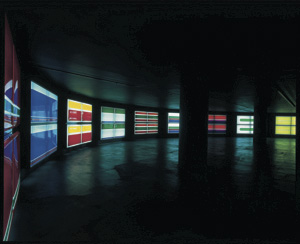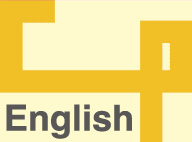Masato Nakamura. Artist. Born in 1963, in Akita Prefecture.
Okabe: There was an artist space in Tokyo called Studio Shokudo, but I would like to ask you about the artist run group which you first initiated, commandN.
Nakamura: If we briefly touch upon the situation in Japan before that that time, a particular feature was the system of rental gallery spaces. From the 60’s to the 70’s this system really developed in the Kanda area, and one could catch a real sense of the independent activity of artists, shaping the arts scene. To organize everything yourself, down to the actual sale of your work was a huge undertaking, and maybe it is a very Japanese work ethic, but at that time it was a system which Europe and America could not even think of. The reason being that even if you are a student, anybody could get their own exhibition together if they paid the rental fee, there were of course good artists amongst these, but in this change of structure the question of “What is art?” becomes lost.
Okabe: More recently galleries with a curated programme have increased in number and there has been a rise in negative criticism of rental spaces.
Nakamura: Yes that’s right. However you have to understand that there are some things you can only do in a rental space. In a commercial gallery the good thing is that they nurture the art market and create very good connections with artists, collectors and art museums. However in the commercial scene it is the buyer who has the initiative. In the 90’s major professional gallerists came to the fore and it was near the end of the century that commandN then emerged. What has been fundamental to this has been an avant garde mind-set, like for example that of High Red Center in the 1960’s, bringing art out onto the streets and the regaining of artists’ independence. It was very much part of commandN’s vision to encourage artists to say something from an independent position, to take the initiative and to join in or infiltrate the society around them. It is the basic way of thinking of commandN to create something new, the short-cut key on a mac computer command+N, creating a new page. And in this new undertaking we are trying to freshly point towards the local art practices of Tokyo and Japan’s provinces with a global perspective.
Okabe: When you first established commandN did you also come up with the idea for AkihabaraTV at the same time?
Nakamura: Actually the idea for AkihabaraTV came first, we set up an office next to Akihabara and brought artists and curators together. Although there were some examples of pioneering alternative art spaces in Tokyo like “Sagacho” run by Kazuko Koike, there were no artist run spaces. AkihabaraTV was a project which hi-jacked the television monitors on sale in the electronics stores of Akihabara and for a limited period of time presented artists’ video work.

Masato Nakamura 「minimal selves」 2001
協力:am/pm Japan Co.,Ltd. FamilyMart Co.,Ltd. LAWSON, INC. Three F Co., LTD. Seven-Eleven Japan Co., Ltd. JR East Convenience Co.,Ltd. POPLAR. CO., LTD. Daily YAMAZAKI CO.,LTD.
© Anne Hardy
Okabe: Within your own work, in your approach towards art, when did you first begin to think about the importance of the involvement with society and contributing to its regeneration?
Nakamura: Particularly from the time when I was studying in Korea for three years, I began to question what I was trying to do and began to think about the impact of education, how to generate and build my own identity, it was a period to reexamine these things. Also in considering a society built on cram schools and exams I have been motivated to publish a book of interviews about art education.
Okabe: You started to make a name for yourself around the time that you went to study in Korea. I thought this was quite unusual. I thought at the time “ah, a new artist has arrived”. Usually all the artists just went to New York.
Nakamura: Well, I kind of shrunk from the commercial culture of America, and I thought well I can go to New York some other time. Korean art was different from Impressionist loving Japan, it was a place of real contemporary art. It really had a greater awareness of the contemporary, and amongst the general people there was a greater appreciation of art as something to be enjoyed. There were also a lot of wealthy people who were generous with their money, supporting the creation of work and also buying it.
Okabe: The modern period also coincided with the colonial period so the position of collections is often quite contested is it not? Recently there has been an attempt to excavate the modern from a new point of view. In the exhibition “Cold Burn”, at the Museum of Contemporary Art Tokyo you presented the convenience store work and the MacDonald’s work, which was also presented in your solo exhibition at SCAI THE BATHHOUSE. I should imagine if you make this kind of work using the signs of commercial establishments it is a very difficult task to negotiate with these companies.
Nakamura: Yes you’re right. That’s because I’m asking please let me use your signs, and please let me use them as art. Usually with trademarks you have one shot and you’re out. But with the work that I created if you experience it one time I think you can sense a difference between the usual Macdonald’s on the street and it is the sharing of this perspective which points towards the possibilities of art. In the case of the convenience store work, first of all 7eleven were the most difficult to talk with, but in the case of MacDonald’s it was much easier to negotiate with them.
Okabe: In that case, if you want a collector you can always sell these works right?
Nakamura: I select the collectors. If it is ok with me and the makers then of course we can sell them. But the usual art museums can’t buy this work. If you can buy art work then I think that during your life time you should try buying it (laughs).
Okabe: In the case of the convenience store and MacDonald’s works I think there are two ways of interpreting them. One is to consider them as a criticism of the consumer society of America, globalization, capitalism, and suggest the similarity of Japan’s own condition, offering a critique or satire as a Japanese artist undertaking such action. On the other hand it can also be viewed, as questioning the meaning of the symbols of the 20th Century, like art itself.
Nakamura: Well of course because they are art works if you look at them from this perspective it is fine. But things which derive from the word capitalism, probably carry a depth which can not be resolved within art. Economists, and financial movers and shakers on the scene have a certain power. Therefore even if I were to satirize the headstrong economics of the director of 7eleven simply as an art work, I can not be completely opposed to it, the essence is completely different. The thing I am interested in, as I said at the beginning, is to reconstruct the value of the encounter with art and the essential elements which go into the formation of art. What we need to consider is how can the social condition found amongst those local elements be invested with a global message which can contribute towards society?

49th Venice Biennale Japanese Pavilion 2001 「QSC+mV/V.V」
© Masato Nakamura
Special Sponsor: McDonald's Company (Japan), Ltd.
Sponsor:kirin Brewery Company, Limited、Panasonic Electric Works Co., Ltd.
Special assistance: Naoshima Contemporary Art Museum/Benesse Corporation
assistance: Toa Resins co.,ltd、Mitsubishi Rayon Co., Ltd.
TAKINAMI co.,ltd、Art planning workshop、Shiraishi Contemporary Art, Inc.
Okabe: After AkihabaraTV, you went on to organize the Sukima (gap) project didn’t you.
Nakamura: The change taking place in Akihabara is really quite remarkable. It has become a place where people are highly critical of whether something is of value or not. If you put out low quality goods nobody will pay any attention to them. Now Akihabara has become a place for Otaku to gather, and anime and figurines from all over the country are on sale here. Therefore we can not help but ask “What is art?”
Also I have begun to consider recently about the differentiation between artist, curator and producer. Work in the arts field is a genre which still hasn’t fully developed, there are a lot of art museums, a lot of work collected, the foundations of education are widening, and there are many excellent people in the field, but there is no work. Most people can’t live off this activity. That’s because people don’t think of generating their own work for themselves or others. People who come to commandN ask things like “I want to become a curator but how can I do this?” and I tell them “You have to at least make your own exhibition first”. Now there are a lot of alternative art spaces both in Japan and world wide, so they are quickly building a network. That’s because the people involved in such projects share the same awareness. And it is with this meaning that commandN exists in this gap which brings so many connections together.
(SCAI THE BATHHOUSE、15th December 2000)
中村政人 アーティスト
岡部:東京にはスタジオ食堂というアーティストランスペースがありましたが、最初に中村さんが運営しているコマンドNについてのお話を伺えればと思います。
中村:その前に日本の状況について少し触れると、特徴となるのは貸し画廊制度で、60年代から70年代にかけて神田を中心として発達し、アーティストの主体的な活動の実感をともなった現場を形成しています。作品を売るところまで自分でやるオールマイティな活動であり、大変日本的ですが、欧米ではまず考えられない制度です。なぜかというと、学生でも誰でもお金を払えば展覧会が出来てしまい、一見作家のように見えるけれど、制度化によって「アートとは何か」という課題が欠落しがちなためです。
岡部:最近企画画廊が増えて、貸し画廊に対しては、ネガティブな認識も多くなってきましたね。
中村:そうねすね。しかし、貸し画廊でしかできないこともあります。コマーシャルギャラリー(企画画廊)の良さは、作品を売りマーケットを育て、作家とコレクター、作家と美術館を結び付けていく力があることです。しかし、コマーシャルのシーンでは、買う人が主導権をとります。90年代に主要なプロのギャラリストが出てきて、世紀末になる頃にコマンドNが登場します。要するに、60年代に街に出ていったハイ・レッド・センターなどのアヴァンギャルド精神と、アーティストの主導権を奪還するためです。作家が主体的に何かを伝え、イニシアティブを持って社会に参加し介入するのが、コマンドNの考えで、その方法がアートという思考回路を通過してでてくる。マッキントッシュのコマンドキー+Nキーつまり「新規ページを開け」というスクリプト自体がコマンドNの基本的な考え方です。東京、あるいは地域において限定して成立するアート、グローバルな視点でかつローカルならではのアートの成立をめざしました。
岡部:コマンドNを立ち上げたのと、秋葉原TVを考えたのは、ほとんど同時なのですか。
中村:秋葉原TVが最初ですが、事務所を秋葉原のそばにつくって一緒にやろうと、アーティストとキュレーターが集まりました。東京には小池一子さんが主宰していた佐賀町などのオールタナティヴスペースの先駆的な例はあっても、アーティスト主導型のスペースが無かったためです。秋葉原TVは、秋葉原の電器屋街にある販売用のテレビモニターを一時的にジャックして、その期間だけ僕らの作った映像作品を流してもらうという企画です。
岡部:ご自分の活動及びアート等を思考するなかで、社会との関わりや還元性みたいなことを考え始めたのはいつごろからですか。
中村:とくに韓国に3年間留学した辺りから、自分がやろうとしていることに対して、ひとつひとつ疑問を持つことと、教育の弊害や影響を、自分のアイデンティティの構築・生成と共に、もう一度見てみる時間があったんですね。予備校や受験を通して社会との関わりを考えはじめ、美術教育に関するインタヴューを本として出版しています。
岡部:中村さんの名前が際立ったのは、韓国に留学された頃からでした。めずらしいなと思って。「ああ、新しいアーティストが出てきた」という気がしました。普通みんなニューヨークへ行きたがりますから。
中村:アメリカの消費文化のようなものにちょっと辟易していたし、ニューヨークへ行くのは、後でいいと思ったから。韓国の美術は、印象派を集めるのが好きな日本とは違って、現代美術です。現代に関しては日本よりも進んでいて、作品を楽しむ視点は韓国の国民性の方が豊かです。お金持ちの人達の幅がとても広いし、上は桁違い、そういう人達は惜しみなく作品をサポートするし、買いますね。
岡部:近代が植民地時代に重なるので、コレクションの位置づけが困難だったからでしょうね。最近新たな視点での近代の発掘が行われています。東京都現代美術館の「低温火傷」展でコンビニの作品と、SYK THE BATHHOUSEの個展でマクドナルドの作品を見ましたが、こうした企業の商標を使う作品の場合、相手方の企業との交渉が大変でしょうね。
中村:そうです。「おたくの看板を僕に使わせて下さい」、しかも「アートで使わせて下さい」と言ってるわけですから。普通は商標権で一発でアウト。でも実現した僕の作品を一度見たり体験すると、街のなかにあるマクドナルドが今までと異なる感じ方ができると思うし、そうした視線の共有の仕方がアートの可能性を示している。コンビニの作品の時には、最初のセブンイレブンが一番大変でした。マクドナルドの場合は、セブンイレブンやローソンの作品の前例があるので、交渉しやすかったです。
岡部:コレクターが欲しいと言えば、売ることはできるわけですね。
中村:コレクターを選ぶわけです。一応僕とメーカーがOKならいい。でも美術館でも並みの美術館は買えないでしょう。買えるもんなら、生きてるうちに買ってみろって思っています(笑)。
岡部:コンビニやマクドナルドなどの作品には2つの見方があると思うんです。ひとつはアメリカの消費社会のいわゆるグローバリズム、資本主義の消費に対しての批判と、さらに類似する日本の状況に対する示唆。日本の作家がそれに対して行為をするということ自体における批判性、あるいは風刺。それともうひとつは、アートと同じように、20世紀のシンボルという意味での表象の意味を問いかける観点。
中村:もちろん美術作品ですから、そういう観点で見ることは、全く問題ないし正しいと思います。ただ資本主義の言葉のところから派生するものは、たぶん美術という中では解決できない言葉の深さがある。経済学者とか、現場で経済を動かしている人たちの力がある。それこそセブンイレブンの社長の経済的な感覚は、僕が単に美術作品としてそれを風刺するような程度のことをしても、全く対抗できるものではないし、質としては全然違うものです。僕の興味は最初に言ったように、このローカルな都市の中でアートの生成を形成する要素とどのように出会い対峙しその価値を組み換えていくのか。そのローカルな要素の中から見いだされた社会性がグローバルな意味でどのようなメッセージとして社会に還元できるのかです。
岡部:秋葉原TVの後で、最後にスキマプロジェクトを手がけられましたね。
中村:秋葉原はすごく変化が激しい。秋葉原ならではの価値をもつ非常に批評性の高い街です。下手な商品を置いても誰も見向きもしない。今はおたくの人達が集まる街になって、アニメやフィギアが全国から集まってくる。だからこそ「アートとはなにか?」と言わざろうえない。また、最近考えていることは、アーティスト、キュレーター、プロデューサーといった職能分化についてです。アートの仕事は、まだ未開発のジャンルで、美術館もたくさんでき、作品も集まり、教育基盤も広がり、優秀な人がいっぱいでてきているけれども、仕事が無い。ほとんどの人が生活できていない。それは自分で仕事を見つけ、生み出そうと思っていないからです。コマンドNに来る人に、「キュレーターになりたいんですけれども、どうしたらいいんですかね?」と尋ねられると、展覧会を自分で一本つくればいいと答えます。しかもアーティストランスペースは、今や世界中にいっぱいあり、すぐに繋がってくれる。やっている人同志が意識を共有しているからです。その意味でも繋がりを導く「スキマ」にコマンドNは存在しているのでしょう。
(SCAI THE BATHH岡部USE、2000年12月5日、参加者:浦野直子、笠原佐知子、國井万紗子、鈴木さやか、テープ起こし担当:國井万紗子)
